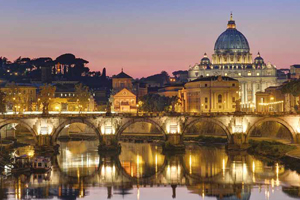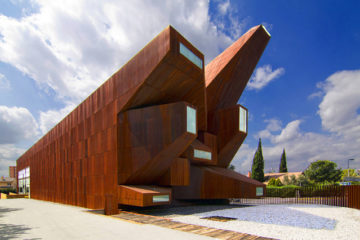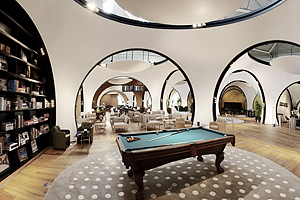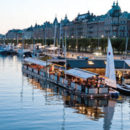
Architecture as a promise of happiness
Just as the smell of freshly baked pizza or the first sip from a glass of Italian wineforetell delights to the senses, any glimpse taken of Italy’s magnificent buildings is enough to overflow anyone with feelings of amazement, joy, curiosity, excitement. The next sight is always better than the previous, and this goes on and on.
Whoever has been to Italy at least once can hardly escape the feeling that almost everything built there was first and foremost made to be liked. And what is likable is also functional enough, as nobody ever complains that beauty is uncomfortable. Some villages are hung on steep hills, some piazzas offer little shade against the scorching heat, and some streets are so narrow that they appear to have been intended to be crowded, but most visitors are charmed with them.
As a former ‘center of the world’ – at least since the days of Ancient Rome (roughly 2,500 years ago) to the first post-Renaissance centuries – Italy is not sought only for its outstanding natural beauty. If there are plenty of mesmerizing landscapes convincing visitors to come for the first time, its man-made wonders are those who make people return.
Italy has the most UNESCO World Heritage Sites (a total of 49) in the world. Although it is only the fifth in terms of incoming foreign turists (46.4 million in 2012), this influx provides a significant yearly revenue ($136.1 billion in 2011, equivalent to 8.1% of GDP). Albeit pleasant, sunbathing and enjoying good food can’t make up for what is often the most overwhelming encounter a tourist and cities more beautifully built that most others in the world, only partly resembling other Mediteraneean milieus.
Stendhal’s syndrome
Depending on how immune to bewilderment contemporary people have become, there are still some who fall prey to a peculiar psychosomatic condition – described by French writer Stendhal (Henri-Marie Beyle) in the first half of the nineteenth century. He ‘fell ill’ during a trip through the Italian Peninsula, precisely in Florence, when he was in the Basilica of Santa Croce – famous for Giotto di Bondone’s frescoes and for being the eternal resting place of Niccolò Machiavelli, Michelangelo Buonarroti and Galileo Galilei.
“I experienced the most intense pleasure art has ever bestowed upon me. I was in a sort of ecstasy, from the idea of being in Florence, close to the great men whose tombs I had seen. Absorbed in the contemplation of sublime beauty… I reached the point where one encounters celestial sensations… Everything spoke so vividly to my soul (…) Life was drained from me. I walked with the fear of falling,” Stendhal recalled in his book Naples and Florence: A Journey from Milan to Reggio (1817).
It’s not hard to imagine that the French author may have been the object of ironies during his lifetime and afterwards, being deemed a self-intoxicated Romantic. Nonetheless, almost 200 years later, an Italian psychotherapist, Graziella Magherini, confirmed that exposure to Florence’s fine art can cause serious symptoms and strikingly similar to Stendhal’s breathlessness, rapid heartbeat, dizziness, and even a loss of consciousness.
In her book, entitled Stendhal’s Syndrome (1989), Magherini claims to have recorded, over a period of two decades, more than 100 occurences of tourists who have suffered similar physical symptoms. The worst cases required hospitalization. According to the psychotherapist, Italians themseleves are immune to this ailment (probably due to super-exposure to architectural beauty), while visitors of Anglo-Saxon origin are the most susceptible of becoming ‘Stendhal patients.’
The Grand Tour (of Italy)
Since the 1660s, wealthy young men from European upper classes (especially from England, later joined by other Northern Europeans, North and South Americans) made a lengthy trip, lasting from a few months to a couple years or so, towards Southern Europe, especially the Italian states. This Grand Tour was meant to be an educational rite of passage, as the travellers were exposed to the ‘roots’ of Western European civilization in Rome, Florence, Venice and Naples.
In the company of a ‘Cicerone’ (guide or tutor), the future statesmen and landlords would view masterpieces, watch theatre plays and operas, listen to the greatest musicians of the time, commission paintings or music pieces, buy sculptures or furniture, and practice their foreign language skills, the customary language of the Tour being French.
To some historians, this trip of a lifetime helped shape the ‘cultural hegemony’ of the ruling classes. These men shared not only wealth and influence, but the same taste of beauty. Like devout Christians yearn for visiting Jerusalem at least once in their lives, and Muslims have a religious duty to go to Mecca, a Grand Tour was both a dream and an obligation – a prerequisite of joining the cultural and political élite of Europe from the late seventeenth to the early nineteenth centuries.
By the mid 1840s, as Bourgeois revolutions began shaking the Old Continent, the Tour became accessible to lower classes, its duration was shortened, and it was made by train. Little by little, the tourists’ focus moved from the Italian Peninsula’s cultural heritage to spending leisure time on its sunny hills and coastlines or in the mountain ski resorts during winter.
Italianate style
Regarding themseleves as more pragmatic than Aristocrats, the nouveaux riches tried to take Italy back home with them, and so did the Italianate buildying style appear in Victorian Britain and in the United States, where it became very fashonable in the 1860s and 1870s.
Irrespective of social class, people wanted to build houses immitating Italian Renaissance villas: symmetrical rectangular shapes, flat roofs, porch topped with balustraded balconies, arches above windows and doors etc. Some of these houses looked nice, but immitating Italy remained a futile attempt, as it’s beauty is not dependant only on a building technique. Building houses ‘like in Italy’ was unable to add Italian authenticity to cities of the Anglo-Saxon world.
“Italian cities have long been held up as ideals, not least by New Yorkers and Londoners enthralled by the ways their architecture gives beauty and meaning to everyday acts,” Californian writer Rebecca Solnit justly observesin her book Wanderlust: A History of Walking (2000).
Up to this day, there are people from all walks of life who have been to Italy 5-6-7 times and still dream of going back, either to unseen corners of the Peninsula or to places that have taken hold of their hearts. They like being there, as their initial expectations have been surpassed; they are sure they will feel great to be there once more.
Maybe they are not falling sick – provided that taking too many selfies won’t be considered a medical condition soon – however, there is a mysteryous bait that draws them to Italy as strongly as what attracted people there in the times where it was said that “All roads lead to Rome.”
If “beauty is the promise of happiness,” as Stendhal puts it, then Italy’s architectural marvels could be the incarnation of that promise, couldn’t they?









